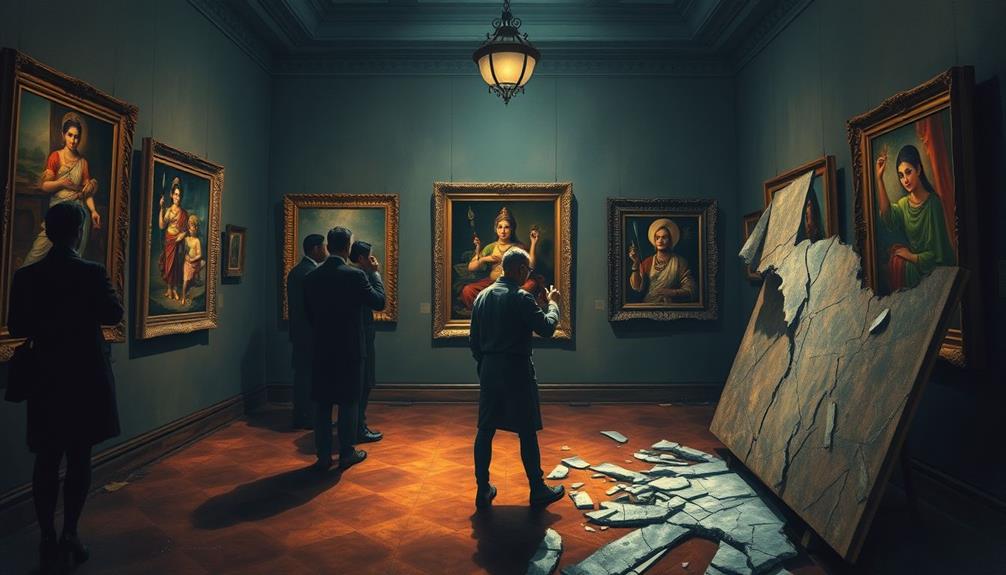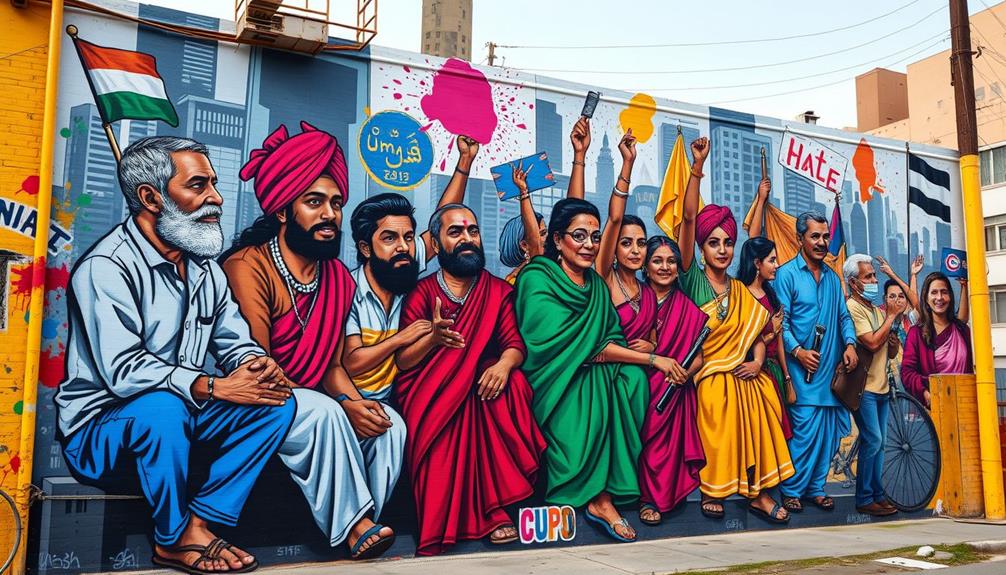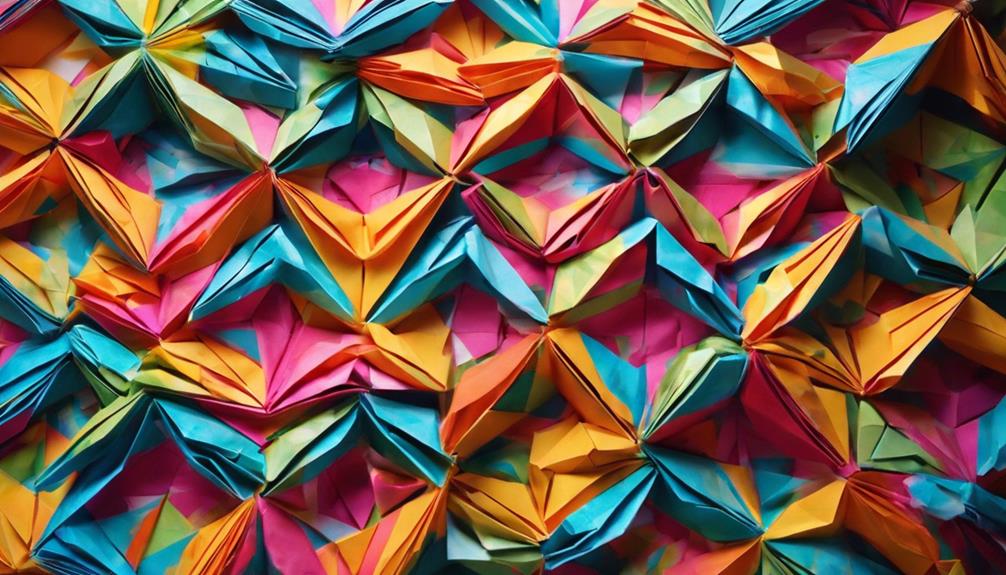Fake art scams are wreaking havoc on the Indian art market, costing genuine artists millions each year. With counterfeit works flooding the market, buyers face confusion, driving down prices for authentic pieces. This not only leads to financial insecurity for artists but also threatens cultural integrity. Legislative efforts, like the proposed ARTIST Act, aim to combat these scams and empower enforcement against fraud. Community advocacy is rising as artists unite for transparency and support. The urgency to strengthen regulations is clear, and there's much more happening in this landscape that you might find enlightening.
Key Takeaways
- Counterfeit art scams significantly undermine the economic stability of Indigenous artists, leading to millions in lost income annually.
- The prevalence of fake art creates market confusion, driving down prices for authentic pieces and jeopardizing artists' financial security.
- Legislative reforms, like the proposed ARTIST Act, aim to enhance enforcement against art fraud and protect Indigenous artists' rights.
- Community advocacy and educational initiatives are crucial for raising awareness about counterfeit art and supporting legitimate artists.
- Strengthening legal frameworks and community vigilance is essential for preserving cultural integrity and promoting the value of authentic Native art.
Current State of Fake Art
In recent years, the Indian art market has faced a troubling surge in counterfeit artworks, with estimates suggesting that around 80% of the U.S. market may be flooded with fakes. This alarming situation primarily revolves around fake Native American art, which undermines the authenticity and retail value of genuine pieces created by Native artists.
Investigations have revealed that many counterfeit items originate from manufacturers in the Philippines, with seized jewelry's retail value potentially doubling its declared import value of $11 million. The lack of empathy and understanding regarding the cultural significance of authentic art, similar to the traits of a narcissistic individual, exacerbates the issue, as many fail to recognize the impact on the artists' livelihoods.
The Indian Arts and Crafts Act aims to protect against this deception, but current penalties, including maximum fines of $250,000, are often viewed as inadequate. High-profile legal actions against gallery owners and individuals selling these fraudulent artworks highlight the widespread nature of art fraud and its devastating market impact.
The prevalence of counterfeit goods not only jeopardizes the economic stability of Native artists but also damages the cultural integrity and storytelling aspect inherent in authentic Indigenous art. Addressing this issue is vital for restoring trust and promoting genuine works that reflect the rich heritage of Native communities.
Legislative Measures and Reforms
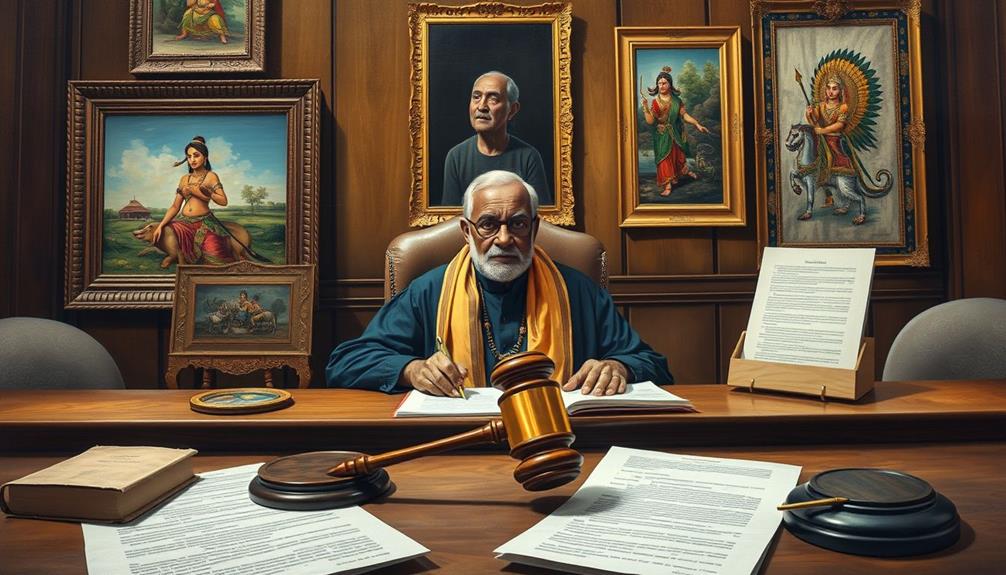
You should know that strengthening the Indian Arts Act is essential in tackling the rise of counterfeit art.
This need for reform is underscored by the increasing incidents of art fraud that undermine the integrity of the art community, as highlighted in discussions about exploring philosophical literature.
The proposed ARTIST Act aims to enhance enforcement mechanisms, giving federal authorities more power to combat art fraud effectively.
As these legislative changes unfold, the focus will be on better protecting Indigenous artists and their authentic works.
Strengthening the Indian Arts Act
Strengthening the Indian Arts Act is vital for protecting the integrity of Native artistic works amidst the rising tide of counterfeit art. The proposed amendments to the Indian Arts and Crafts Act aim to enhance protections for Native American artists, expanding federal enforcement to include Native Hawaiians for the first time.
These updates recognize the sophistication of art fraud, addressing the alarming statistic that around 80% of the U.S. Indian art market is believed to consist of counterfeit goods. Additionally, just as precious metals investments have gained traction due to their security and inflation hedging capabilities, the art market must adapt to safeguard its value and authenticity through legislative measures. The importance of staying informed about these developments is significant for artists and collectors alike.
The ARTIST Act seeks to bolster enforcement mechanisms by granting federal officers new powers for arrests, searches, and seizures related to counterfeit art. By establishing an Indian Arts and Crafts Forfeiture Fund, the Act guarantees that enforcement costs are covered while providing mandatory training for federal law enforcement on relevant legislation.
As the Senate Committee on Indian Affairs reviews these proposed amendments, public comments are accepted until April 14, allowing you to voice your support for tighter regulations.
Strengthening the Indian Arts Act won't only protect Native artistic works but also restore trust in the art market, assuring that genuine creations receive the recognition they deserve.
Enhancing Enforcement Mechanisms
Recent developments highlight the pressing need for enhanced enforcement mechanisms to combat counterfeit Native art effectively. The proposed ARTIST Act aims to bolster federal law enforcement's authority by granting new powers for arrests and searches related to violations of the Indian Arts and Crafts Act.
This reform is vital for conducting thorough investigations into sophisticated counterfeit operations that plague the market, much like the benefits of diversifying investments in a volatile economic environment.
To guarantee robust enforcement, the establishment of the Indian Arts and Crafts Forfeiture Fund will provide essential resources for costs associated with these efforts. Additionally, the ongoing training of federal officers on relevant legislation will improve their capacity to identify and prosecute violations, thereby boosting accountability.
Recent Senate Committee amendments focus on strengthening authenticity requirements in Indigenous art production and increasing penalties for those who violate these laws. Current penalties, including fines up to $250,000, are seen as inadequate by officials who recognize the need for more severe consequences to deter counterfeiters.
Economic Consequences for Artists
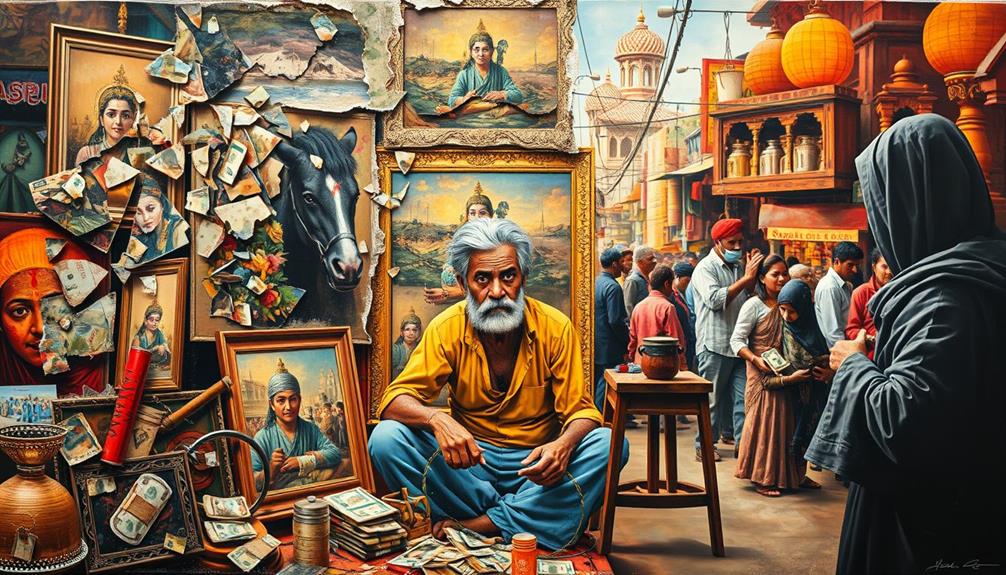
When counterfeit art floods the market, you face lost income opportunities that can cripple your financial stability.
The erosion of market value for authentic pieces means you struggle to earn a fair price for your work. This situation not only affects your livelihood but also threatens the cultural heritage you represent.
Additionally, the psychological effects of such scams can lead to feelings of loss and anxiety among artists, as they grapple with the impact on their creative expression and professional identity, similar to how individuals cope with emotional recovery strategies during challenging times.
Lost Income Opportunities
The impact of fake art scams on Indigenous artists is staggering, with estimates suggesting millions lost annually due to counterfeit items. In the Indian art market, up to 80% of what's available might be fake, severely limiting sales opportunities for genuine Native artists.
This saturation of counterfeit art not only confuses buyers but also drives down prices for authentic pieces, much like how the prevalence of counterfeit goods affects the value of unique home decor items in the Modern Farmhouse Decor Trends. As a result, you may find it increasingly difficult to get the income you deserve for your work.
Many artists report feeling pressured to abandon their crafts, as financial insecurity looms large due to art fraud. The presence of counterfeit items can create an environment where your talent and hard work go undervalued.
With legitimate sales opportunities dwindling, your income potential shrinks considerably. Federal law enforcement is aware of these issues and is investigating counterfeit networks.
They've discovered that the retail value of seized fake jewelry often doubles the declared value, highlighting the substantial loss for authentic artists like you. This situation not only affects your income but also threatens the cultural heritage that your art represents, emphasizing the urgent need to tackle this issue head-on.
Market Value Erosion
Counterfeit art isn't just a nuisance; it's actively eroding the market value of genuine Indigenous art. As a result, Native artists face significant challenges in maintaining their economic stability. The prevalence of counterfeit goods—estimated to make up 80% of the U.S. Indian art market—leads to substantial revenue loss for authentic creators. This art fraud creates market saturation, forcing many legitimate artists to abandon their crafts due to financial instability.
| Issue | Impact on Artists | Overall Consequence |
|---|---|---|
| Market Value Erosion | Decline in art prices | Reduced income and prestige |
| Counterfeit Art | Increased competition | Loss of authenticity |
| Revenue Loss | Inability to sustain practice | Diminished cultural heritage |
| Financial Instability | Struggles to sell art | Artist exodus from market |
| Market Saturation | Overwhelmed by fakes | Erosion of community support |
The combined effects of these issues threaten the integrity of the Indian art market. As you witness these changes, remember that supporting genuine artists is crucial for preserving their craft and ensuring the future of Native art.
Community Response and Activism
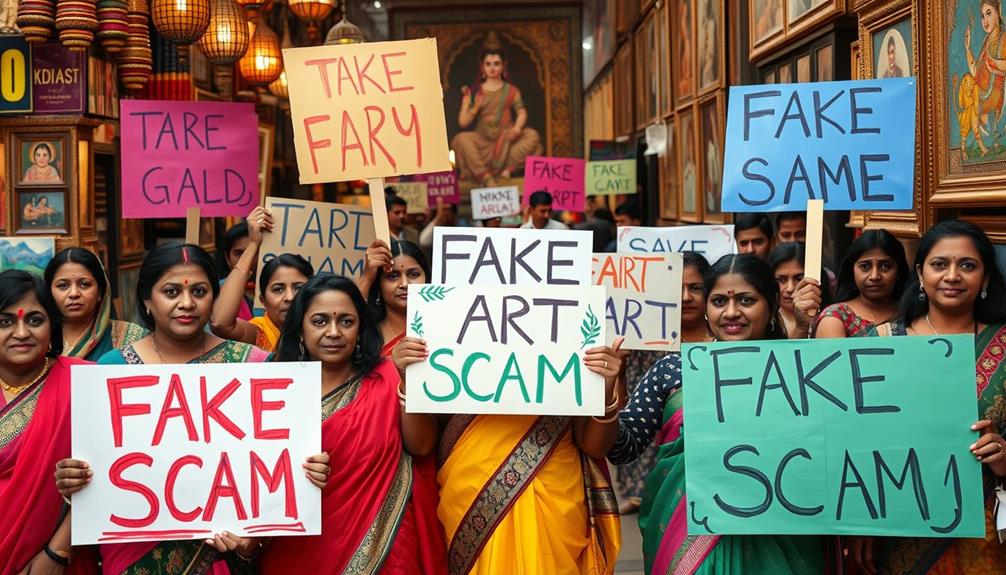
Many artists and community organizations are taking a stand against the rise of fake art scams in the Indian art market. Their efforts focus on preserving authenticity and protecting Indigenous artistic integrity.
Reviving old friendships can be an example of how community bonds strengthen as they endeavor to support genuine artists. Here are three key strategies they employ:
- Advocating for stricter regulations: Community organizations push for legal frameworks that combat counterfeit Native art, guaranteeing that authentic artists receive the recognition and profits they deserve.
- Raising awareness at local events: Platforms like Santa Fe's summer Indian Market highlight legitimate Indigenous artists, fostering community support while exposing fraud in the art market.
- Promoting transparency and accountability: Social media backlash against misrepresentation has sparked demands for clear funding and affiliation disclosures, emphasizing the importance of vigilance against fraudulent claims.
Grassroots movements unite Indigenous artists, urging government intervention to protect their work and guarantee profits return to their communities.
By collectively advocating for these initiatives, they not only address the immediate threat of counterfeit art but also build a more resilient and transparent art community.
Together, they're endeavoring to uphold the value of authentic artistry and defend against the pervasive fraud that threatens their cultural heritage.
Educational Initiatives for Awareness
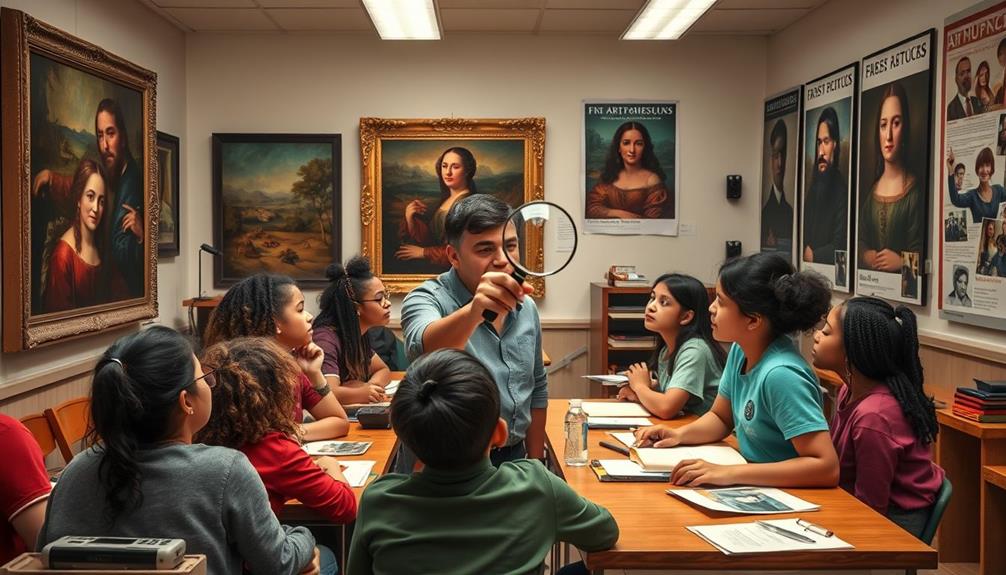
Community activism lays a solid foundation for educational initiatives aimed at raising awareness about fake art scams in the Indian art market. By collaborating with online platforms, the Indian Arts and Crafts Board conducts workshops and seminars, especially during events like Santa Fe's summer Indian Market.
These educational initiatives focus on the importance of authenticity in Indigenous art, equipping buyers with the knowledge to identify counterfeit Native art and understand the implications of purchasing fraud. Additionally, fostering social connections within the community can help amplify the message of authenticity in art, creating a support network that encourages informed purchasing decisions.
Utilizing technology for awareness campaigns can also enhance outreach efforts, ensuring a broader audience is engaged in discussions about caregiver support resources.
The Indian Arts and Crafts Act plays a significant role in ensuring sellers provide accurate information about the origin and authenticity of their items.
Educational efforts emphasize compliance from galleries and retailers while raising awareness about the economic impact of counterfeit art on legitimate Indigenous artists. Community outreach programs and social media campaigns further amplify this message, highlighting the cultural significance of authentic Indigenous work.
Future Challenges and Opportunities
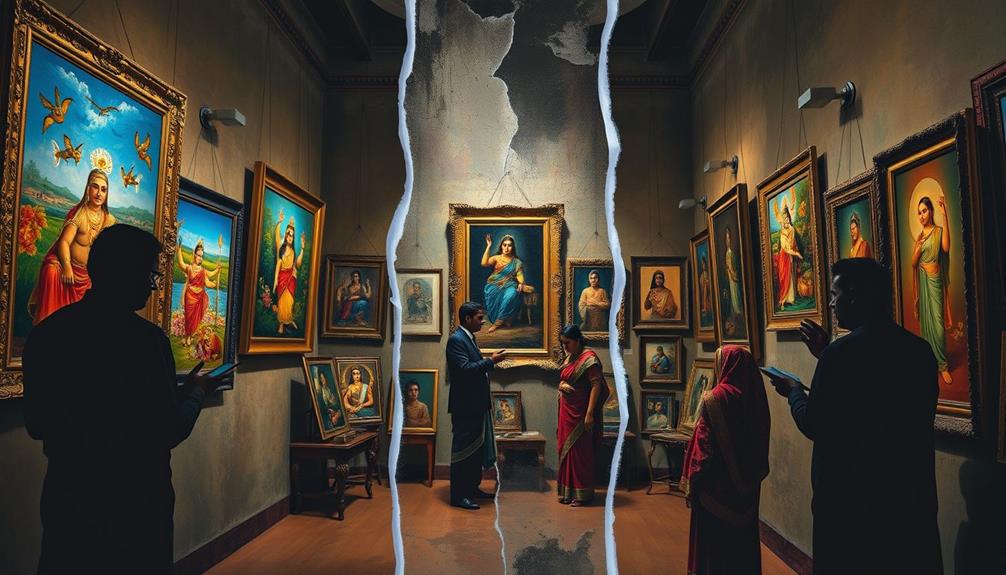
The Indian art market stands at a crossroads, facing both significant challenges and promising opportunities as it grapples with the pervasive issue of counterfeit art. To navigate this landscape, consider these key factors:
- The need for stronger legal frameworks to combat art fraud.
- The importance of community vigilance in preserving cultural integrity. Additionally, implementing thorough best practices for employee background checks could help foster a more secure environment within the art community.
- The potential for educational initiatives to promote authentic Native art.
With up to 80% of the market possibly made up of counterfeit items, the economic viability for Indigenous artists is at stake. Legislative efforts like the proposed ARTIST Act aim to address this crisis by modernizing protections and expanding enforcement mechanisms against sophisticated international counterfeiting operations.
However, the existing penalties under the Indian Arts and Crafts Act remain insufficient to deter counterfeiters effectively.
Emerging from these challenges are opportunities for a sustainable market, driven by community support and awareness. By investing in educational initiatives, you can help raise awareness about the significance of purchasing authentic Native art.
This collective effort can foster a thriving art ecosystem, ensuring that Indigenous craftsmanship is honored and preserved for future generations.
Frequently Asked Questions
What Impact Does the Production of Fake Art Have on Indigenous Artists?
When you consider the production of fake art, it directly undermines Indigenous artists. You'll notice their livelihoods suffer, as these counterfeits flood the market, making it hard for genuine creators to thrive and maintain their cultural heritage.
What Is Indian Art Influenced By?
Indian art's a vibrant tapestry woven from diverse cultural threads, influenced by Indigenous traditions, spiritual beliefs, and historical narratives. You'll find it reflects unique identities while embracing modern themes that resonate with contemporary experiences.
Is It a Crime to Sell Fake Art?
Yes, it's a crime to sell fake art. Misrepresenting artwork as authentic can lead to serious legal consequences, including hefty fines and imprisonment. Always verify authenticity to protect yourself and support genuine artists.
Is There a Market for Native American Art?
You might think there's a thriving market for Native American art, and you're right! But beware—knowing the difference between authentic pieces and counterfeits is essential to truly appreciating and supporting Indigenous artists.
Conclusion
As you navigate the vibrant corridors of the Indian art market, remember: the shadow of fake art scams looms large. Artists struggle, and the integrity of creativity hangs by a thread. Will you stand by as these scams erode the very essence of art? Or will you take action, joining the fight for authenticity? Your awareness could spark change, ushering in a future where true talent shines bright, free from deception. The choice is yours—what will you do?
